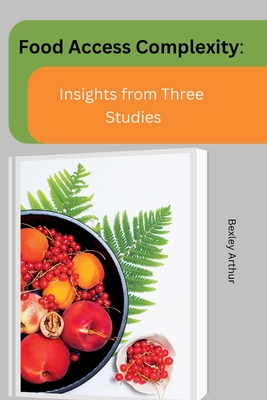You are here
Back to topFood Access Complexity: Insights from Three Studies (Large Print / Paperback)
Description
A significant segment of American society faces injustice when it comes to accessing healthy food options. Many neighborhoods suffer from a lack of supermarkets, particularly in areas predominantly inhabited by people of color and low-income communities. Research indicates that 12.7% of census tracts defined as low-income are situated far away from the nearest supermarkets, with distances of 1 mile for urban tracts and 10 miles for rural tracts (Rhone et al., 2017). This inequity in food access is exacerbated by the urbanization and the dominance of retail food markets, which have left these communities deprived of healthy food outlets but inundated with unhealthy food stores and fast-food restaurants (Eisenhauer, 2001; Kaufman, 1999; Bitler and Haider, 2010; Helling and Sawicki, 2003; Kwate, 2008; Raja, Ma, and Yadav, 2008; Alviola et al., 2013).
Moreover, defining what constitutes good food access for society or individual households poses a challenge for researchers. Factors such as where to purchase food, travel distances, and food choices are complex phenomena influenced by various parameters, including social, economic, cultural, behavioral, and mobility factors within households (Shaw, 2006). For instance, while one household may prefer to meet its food needs at neighborhood stores, others may travel outside their communities for specific reasons (Clifton, 2004; LeDoux and Vojnovic, 2013; Shannon, 2014). Even if two households make purchases from the same store, their food choices can differ significantly in terms of healthiness (Handbury, Rahkovsky, and Schnell, 2015). In other words, the challenges and barriers related to food access differ from one household to another, despite sharing the same food environment.
Given the complexities of food access, researchers from diverse fields such as sociology, public health, dietetics, economics, and consumer sciences have turned their attention to this issue. Urban planning, in particular, has emerged as a discipline that addresses the problem of achieving fair and adequate food access. Urban scholars and planners must consider how to create an efficient environment in which households and individuals can affordably and healthily meet their food demands. Consequently, this book aims to contribute to the ongoing discussions on food access by conducting research in this area.
The book primarily revolves around three papers, each addressing specific scholarly concerns. The first paper explores when people prefer to shop at their nearest supermarkets or superstores. The second paper investigates the proximity of households' main food purchases to their homes. Finally, the third paper examines the household sub-population characteristics that influence the decision to purchase food for home cooking rather than consuming meals away from home or opting for ready-to-eat food. The following paragraphs provide a brief overview of each chapter in the book.
